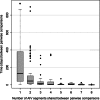Spread and persistence of influenza A viruses in waterfowl hosts in the North American Mississippi migratory flyway
- PMID: 25741003
- PMCID: PMC4442537
- DOI: 10.1128/JVI.03249-14
Spread and persistence of influenza A viruses in waterfowl hosts in the North American Mississippi migratory flyway
Abstract
While geographic distance often restricts the spread of pathogens via hosts, this barrier may be compromised when host species are mobile. Migratory waterfowl in the order Anseriformes are important reservoir hosts for diverse populations of avian-origin influenza A viruses (AIVs) and are assumed to spread AIVs during their annual continental-scale migrations. However, support for this hypothesis is limited, and it is rarely tested using data from comprehensive surveillance efforts incorporating both the temporal and spatial aspects of host migratory patterns. We conducted intensive AIV surveillance of waterfowl using the North American Mississippi Migratory Flyway (MMF) over three autumn migratory seasons. Viral isolates (n = 297) from multiple host species were sequenced and analyzed for patterns of gene dispersal between northern staging and southern wintering locations. Using a phylogenetic and nucleotide identity framework, we observed a larger amount of gene dispersal within this flyway rather than between the other three longitudinally identified North American flyways. Across seasons, we observed patterns of regional persistence of diversity for each genomic segment, along with limited survival of dispersed AIV gene lineages. Reassortment increased with both time and distance, resulting in transient AIV constellations. This study shows that within the MMF, AIV gene flow favors spread along the migratory corridor within a season, and also that intensive surveillance during bird migration is important for identifying virus dispersal on time scales relevant to pandemic responsiveness. In addition, this study indicates that comprehensive monitoring programs to capture AIV diversity are critical for providing insight into AIV evolution and ecology in a major natural reservoir.
Importance: Migratory birds are a reservoir for antigenic and genetic diversity of influenza A viruses (AIVs) and are implicated in the spread of virus diversity that has contributed to previous pandemic events. Evidence for dispersal of avian-origin AIVs by migratory birds is rarely examined on temporal scales relevant to pandemic or panzootic threats. Therefore, characterizing AIV movement by hosts within a migratory season is important for implementing effective surveillance strategies. We conducted surveillance following birds along a major North American migratory route and observed that within a migratory season, AIVs rapidly reassorted and gene lineages were dispersed primarily within the migratory corridor. Patterns of regional persistence were observed across seasons for each gene segment. We show that dispersal of AIV gene lineages by migratory birds occurs quickly along migratory routes and that surveillance for AIVs threatening human and animal health should focus attention on these routes.
Copyright © 2015, American Society for Microbiology. All Rights Reserved.
Figures





References
Publication types
MeSH terms
Grants and funding
LinkOut - more resources
Full Text Sources
Other Literature Sources

